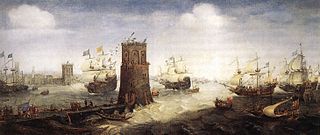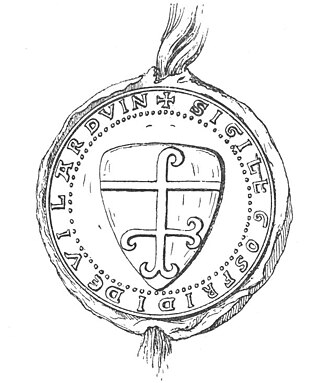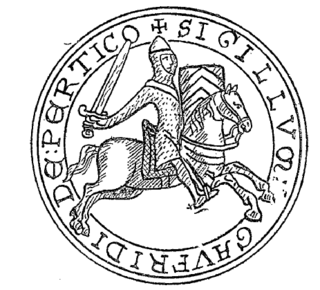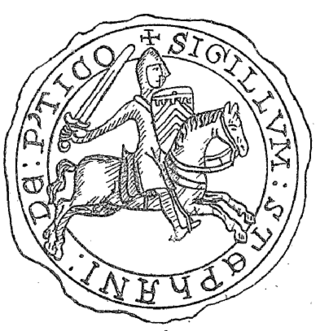
Year 1244 (MCCXLIV) was a leap year starting on Friday of the Julian calendar.

The Fourth Crusade (1202–1204) was a Latin Christian armed expedition called by Pope Innocent III. The stated intent of the expedition was to recapture the Muslim-controlled city of Jerusalem, by first defeating the powerful Egyptian Ayyubid Sultanate. However, a sequence of economic and political events culminated in the Crusader army's 1202 siege of Zara and the 1204 sack of Constantinople, rather than the conquest of Egypt as originally planned. This led to the Partitio terrarum imperii Romaniae or the partition of the Byzantine Empire by the Crusaders and their Venetian allies leading to a period known as Frankokratia, or "Rule of the Franks" in Greek.

The Fifth Crusade was a campaign in a series of Crusades by Western Europeans to reacquire Jerusalem and the rest of the Holy Land by first conquering Egypt, ruled by the powerful Ayyubid sultanate, led by al-Adil, brother of Saladin.

William I of Champlitte (1160s-1209) was a French knight who joined the Fourth Crusade and became the first prince of Achaea (1205–1209).

Geoffrey I of Villehardouin was a French knight from the County of Champagne who joined the Fourth Crusade. He participated in the conquest of the Peloponnese and became the second prince of Achaea.

The Diocese of Autun (–Chalon-sur-Saône–Mâcon–Cluny), more simply known as the Diocese of Autun, is a Latin Church diocese of the Catholic Church in France. The diocese comprises the entire Department of Saone et Loire, in the Region of Bourgogne.

Othon de la Roche, also Otho de la Roche, was a Burgundian nobleman of the De la Roche family from La Roche-sur-l'Ognon. He joined the Fourth Crusade and became the first Frankish Lord of Athens in 1204. In addition to Athens, he acquired Thebes by around 1211.

Walter III of Châtillon was a French knight and Lord of Châtillon, Montjay, Troissy, Crécy et Pierrefonds until his death in 1219. With his marriage, he became Count of Saint-Pol. He was also the Butler of Champagne and the Seneschal of Burgundy.
Philip was the second eldest son of Prince Philip I of Taranto and Thamar Angelina Komnene. His older brother, Charles, died in 1315. On 19 April 1319, his father granted him the title of Despot of Romania, which actually corresponded to rule over a small part of Albania, but also to the Prince of Taranto's claim on the Despotate of Epirus to the south. In May 1321, Philip was engaged to Beatrice, daughter of Count Louis I of Clermont. She brought as her dowry the 40,000 livres tournois, which Louis had agreed to pay Duke Odo IV of Burgundy in exchange for Odo's claim to the Principality of Achaea. Instead, Prince Philip had arranged to purchase Odo's rights for the same amount and marry his son to Louis's daughter. The engagement with Beatrice was canceled by 1329, when Philip married Violante (Yolanda), daughter of King James II of Aragon. In 1328, Philip's father decided to send a fleet to conquer the Despotate of Epirus. The fleet finally embarked in 1329. The younger Philip got as far as Nafpaktos, but on the eve of launching the land expedition, he died. Philip predeceased his father. Violante, his widow, died in 1353.
Walter of Montbéliard was regent of the Kingdom of Cyprus from 1205 to 1210, and Constable of Jerusalem from around 1204 to his death.

Geoffrey III was the count of Perche from 1191 until his death.

Renard II, also spelled Reynald, Raynald, Rainard or Renaud, was the count or lord of Dampierre-le-Château in the Astenois. His lordship lay partly within the Holy Roman Empire, but he was also a direct vassal of the Count of Champagne in the Kingdom of France.

Geoffrey V, nicknamed le Trouillard, was the Lord of Joinville from 1190 until his death in late 1203 or early 1204. He was also the hereditary seneschal of the County of Champagne. He went on both the Third Crusade (1189–90) and the Fourth Crusade (1202–04), where he died.
Geoffrey IV, called the Younger, was the Lord of Joinville from 1188 until his death on the Third Crusade two years later. He is surnamed Valet by Alberic of Trois-Fontaines.
Martin was the abbot of the Cistercian monastery of Pairis in Alsace, then part of the German kingdom in the Holy Roman Empire. Martin played a supporting role on the Fourth Crusade. He was a major source for the Historia Constantinopolitana, a history of the Fourth Crusade written by the monk Gunther of Pairis. Gunther's Historia serves as both a eulogy on the life of Martin and also an account of the translation of relics Martin brought to Pairis from the crusade. Gunther describes Martin as pleasant-looking, affable, eloquent, humble and wise.

Stephen du Perche was a French nobleman and crusader. He was a partisan of the Plantagenets in their conflict with the French crown and held fiefs from them. A younger son, he governed the County of Perche on behalf of his father and brother during their absence on crusade. He himself joined the Fourth Crusade in 1202 and travelled to the Holy Land. Afterwards, he went to the Latin Empire and was appointed duke of Philadelphia in Asia Minor in 1204. He died in battle against the Bulgars.
Thierry of Flanders was a Flemish nobleman and crusader active in 1197–1207.
Guy was the sixth Cistercian abbot of Vaux-de-Cernay from 1181 until 1210 and then the bishop of Carcassonne from 1212 until his death. The crusades dominated his life. He was a preacher, organizer and spiritual leader of the Fourth Crusade, which he abandoned after it turned against fellow Catholics, and also of the Albigensian Crusade against heretics.
Guigues III, also numbered Guigues IV, nicknamed Branda, was the count of Forez from 1199 until his death while on the Fourth Crusade.

This chronology presents the timeline of the Crusades from the beginning of the Third Crusade, first called for, in 1187 to the fall of Acre in 1291. This is keyed towards the major events of the Crusades to the Holy Land, but also includes those of the Reconquista, the Popular Crusades and the Northern Crusades.